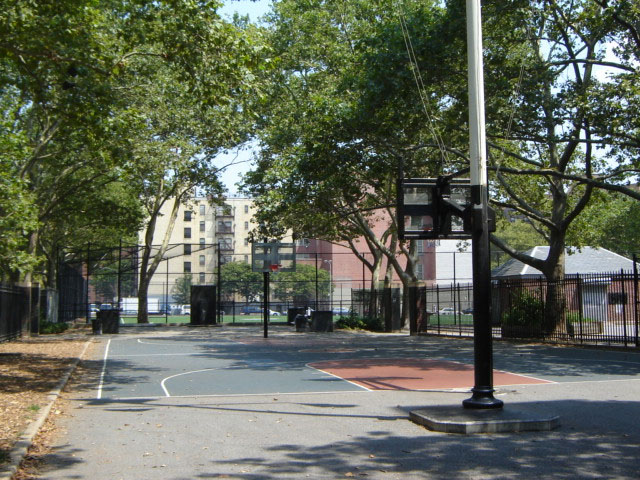
Baruch-Playground

Baruch-Playground2

Baruch-Playground3
Place Category: Parks and Playgrounds
This large, unadorned park pays tribute to two generations of New Yorkers whose work, directly and indirectly, helped bring health and recreation amenities to the masses. By the late nineteenth century, New York City’s population had reached 1.4 million, and was growing rapidly. New immigrants were forced into congested tenement districts where overcrowding threatened their health and welfare. Epidemics of cholera and typhoid raged through these downtown slums in the 1880s and 1890s, owing mainly to the lack of basic sanitation facilities such as toilets and baths. At the turn of the century, these overcrowded neighborhoods averaged one bathtub for every 79 families, while on some blocks the proportion was a staggering one bathtub for every 440 families.
Dr. Simon Baruch (1840-1921), a former surgeon in the Confederate Army during the Civil War, moved to New York in 1881 and established himself as physician in the tenement-laden Lower East Side. Witnessing firsthand the debilitating effects of poor sanitation on the battlefield and in slums, Baruch became convinced that municipally-run public bathing facilities were necessary. He voiced the first public plea for bathhouses in this country in an 1889 New York Times editorial. The public’s reaction was skeptical, with even Mayor Hugh J. Grant (1852-1910) scoffing “The people won’t bathe.” In 1895, despite opposition, Baruch secured legislation requiring local health boards to build public baths.
In 1901, the city completed and opened its first free public bathhouse on this site. The bathhouse featured an indoor and an outdoor bathing pool, 45 showers and 5 tubs for men, as well as 22 showers and 5 tubs for women. Because of its location, city officials designated it the Rivington Street Bath. In 1917, the city changed the name of the bathhouse, dedicating it to Dr. Baruch for his unswerving commitment to public health.
In 1939, Bernard Baruch (1870-1965), son of Dr. Baruch and noted financier, donated most of the land for this park to the city. Parks assumed jurisdiction over the land that same year. Overrun by tenements, the area surrounding the bathhouse had again become a haven for overcrowding. Bernard hoped that his gift would restore his father’s vision for the bathhouse. In 1940, Parks renovated the bathhouse and constructed a playground on this site. Originally, the playground featured two handball courts, a basketball court, a softball field, a comfort station, a memorial flagpole, and play equipment.
Since 1951, Parks has operated the park through an arrangement with the New York City Housing Authority (NYCHA). In 1934, Mayor Fiorello LaGuardia (1882-1947) established the NYCHA as the first public housing authority in the nation, and charged it with building low income housing in New York. The NYCHA today holds title to the land surrounding and incorporating the park. Parks therefore administers this parkland for the NYCHA. In recognition of Bernard Baruch’s generosity, both the park and the housing development were named in his honor in 1951.
In 1975, during the depths of a long fiscal crisis, the City closed and sealed the bathhouse, which had become too dilapidated to operate. That same year, Baruch Playground underwent a renovation that included the installation of metal frame timber climbing equipment and black-top surfacing. Today, the playground features benches underneath the shade of London planetrees (Platanus x acerifolia), as well as spaces for league and recreational softball, flag-football, basketball and handball. In 2000, as part of the Handball Court Initiative, the handball courts were renovated.
- Baruch Playground
New York
New York
10002
United States No Records Found
Sorry, no records were found. Please adjust your search criteria and try again.
Google Map Not Loaded
Sorry, unable to load Google Maps API.
-



